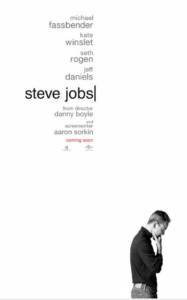
 Who was Steve Jobs? We know he was a visionary – a captain of industry that revolutionized the way we interact with technology. But who was he off the stage?
Who was Steve Jobs? We know he was a visionary – a captain of industry that revolutionized the way we interact with technology. But who was he off the stage?
With “Steve Jobs,” Oscar winning director Danny Boyle (“Slumdog Millionaire”) provides us with an utterly unique method of answering the existential Jobs question. It’s a captivating film taking us behind the curtain. And what we learn might not be easy to digest.
By adapting Walter Isaacson’s bestselling book, screenwriter Aaron Sorkin manages to top his fine Academy Award winning work in writing “The Social Network” by constructing a transformative framework beyond his typical assaultive and engaging dialogue.
The very structure of “Steve Jobs” is a marvel. We get three critical events that shape Jobs: (1) the launch of the McIntosh in 1984; (2) The launch of the NeXT computer in 1988; and (3) The launch of the iMac in 1998.
It would be trite to say that there is something positively Dickensian about the narrative structure, but doggone it, Jobs (played seamlessly by the gifted Michael Fassbender) certainly qualifies for the Scrooge role. This is especially true with regard to his daughter, who we first meet when she is 5.
Even though a paternity test and judge’s order has legally confirmed his parentage, he still denies that the little girl is his. He’s ruthless about it in 1984, but as time passes, things begin to change. Still, the Scrooge catchphrase “Bah, humbug” appears to be always on the tip on his tongue. Whether he’s truly in denial or merely playing out some long game is uncertain, but what is certain is his unbroken devotion to his vision.
One constant is Jobs’ righthand woman Joanna Hoffman (Kate Winslet), his marketing executive who remains with him even when he is not at Apple. As his Jacob Marley type, Hoffman helps brutally guide Jobs through each event. She is his confidant and the voice of reason for him when he is at his most unreasonable.
And Winslet is terrific in the role, adopting a slight Polish accent that more than makes up for her work in the “Divergent” series. The relationship that Hoffman has with Jobs is like that of a spouse, but there is a reserved Platonic quality that makes it really interesting to observe.
Rounding out the key fig- ures in Jobs’ life are John Sculley (Jeff Daniels), the Apple CEO who left Pepsi to helm a computer company, and Steve Wozniak (Seth Rogen), his partner in crime who built their first computer in a garage. Sculley is the corporate animal, but also, one who cares for Jobs, almost like the father he always wanted. Jobs was adopted, which appears
to have affected everything he does. Wozniak is the hardware genius, who acts as Jobs’ socially stunted younger brother.
Rogen is excellent in the Wozniak role that is perfect for him. He has some of the best scenes in the film including one where he questions what Jobs does. Apparently, Jobs writes no code, builds no computers, and isn’t even a designer, according to Wozniak. But Jobs astutely asserts himself by saying that while Wozniak is first chair, Jobs is the conductor and “plays the orchestra.”
“Steve Jobs” is more an Aaron Sorkin film than one typical for Danny Boyle, but there are moments when Boyle’s visual flair shines through. The three segments have distinctly different formats.
The early events in 1984 are shot in 16mm film, the 1988 NeXT launch in 35mm, and the later iMac launch is capture in Arri digital. The visuals inform as to the time period. It’s a subtle and clever technique that makes great
use of the old and the new. Of course, the characters age as time passes, and by the end, Fassbender convincingly looks like the Jobs we knew so well.
It is uncanny to follow the transformation.
But as unique and narratively tight as “Steve Jobs” is, do we learn anything significant about the great innovator of our time? I think so but not necessarily from a factual standpoint. Like the 2006 film “The Queen,” the events on display in this film are merely educated guesses as to what actually happened and what was said behind the scenes. Therefore, it is possible that Sorkin and Boyle have got it all wrong.
But assuming that the viewer knows that liberties with the truth have been taken, it matters not that accuracy may be forfeited. The emotions and spirit feels right or appropriate, even if the facts aren’t. A peek behind the curtain this interesting and finely crafted, even if fictionalized, is a worthy investment.
